A Detailed Analysis: Inflation's Impact and Solutions for Tourism
VerifiedAdded on 2023/06/04
|9
|2055
|359
Report
AI Summary
This report examines the significant impact of inflation on the tourism industry, addressing its causes and effects on businesses and consumers. It analyzes both quantitative and qualitative research, including statistical data on inflation rates and their consequences for SMEs and the tourism sector. The report explores the positive and negative impacts of inflation, such as higher profits versus increased operational costs and unemployment. It recommends solutions such as controlling money supply, managing prices and wages, and using exchange rate pegging to mitigate the negative effects of inflation. The conclusion emphasizes the necessity of implementing effective strategies to ensure the industry's sustained functionality and competitive edge in a challenging economic climate.
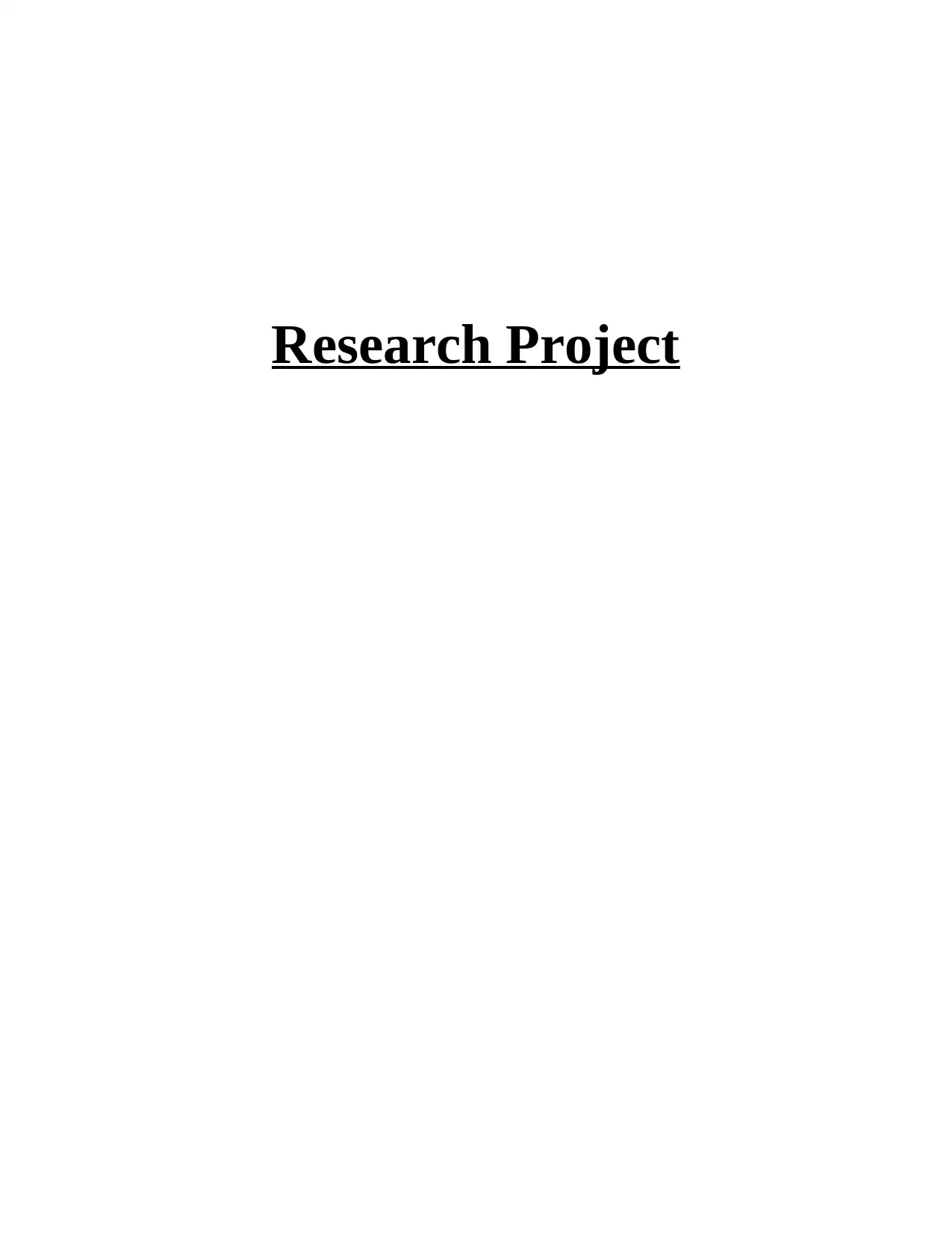
Research Project
Paraphrase This Document
Need a fresh take? Get an instant paraphrase of this document with our AI Paraphraser
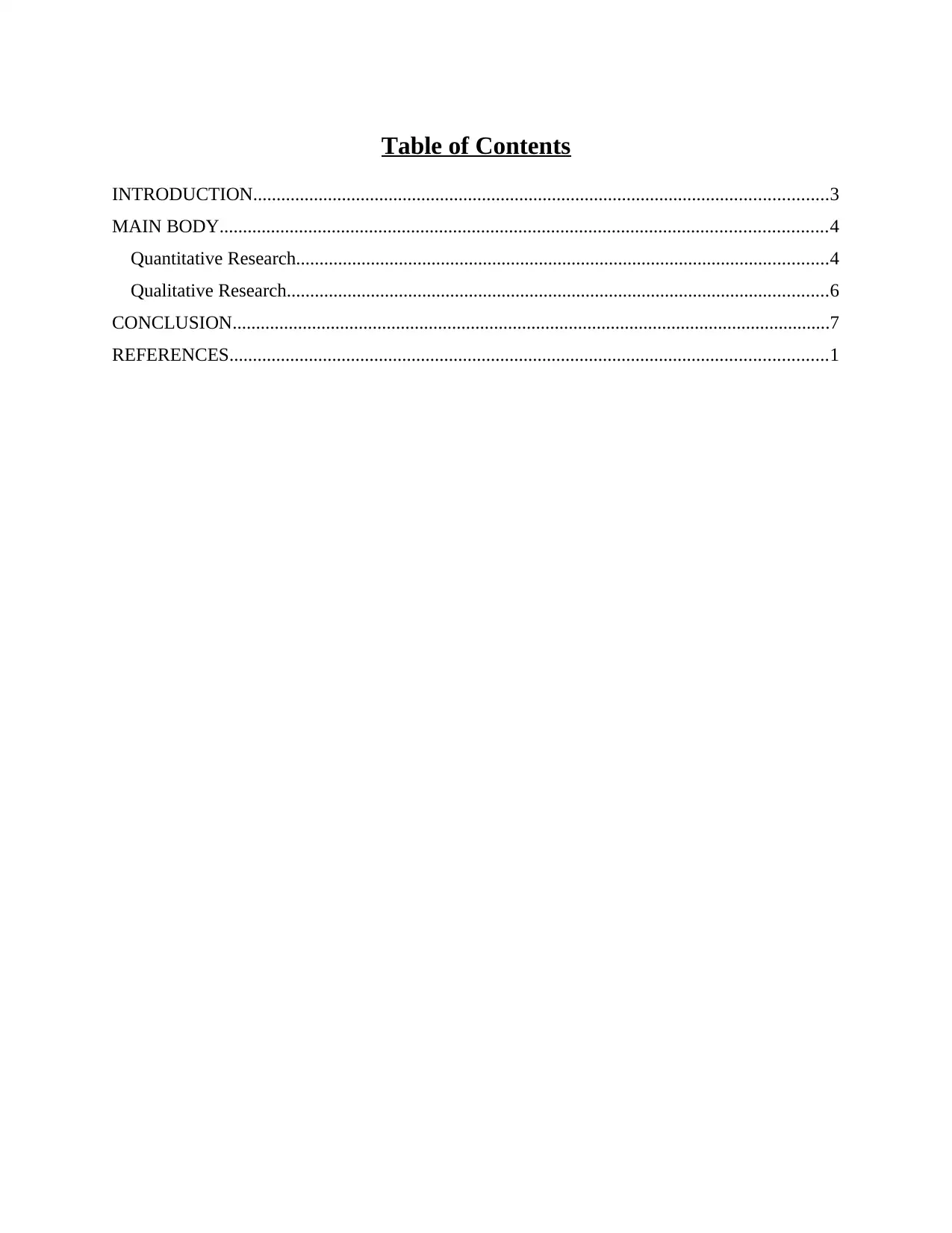
Table of Contents
INTRODUCTION...........................................................................................................................3
MAIN BODY..................................................................................................................................4
Quantitative Research..................................................................................................................4
Qualitative Research....................................................................................................................6
CONCLUSION................................................................................................................................7
REFERENCES................................................................................................................................1
INTRODUCTION...........................................................................................................................3
MAIN BODY..................................................................................................................................4
Quantitative Research..................................................................................................................4
Qualitative Research....................................................................................................................6
CONCLUSION................................................................................................................................7
REFERENCES................................................................................................................................1
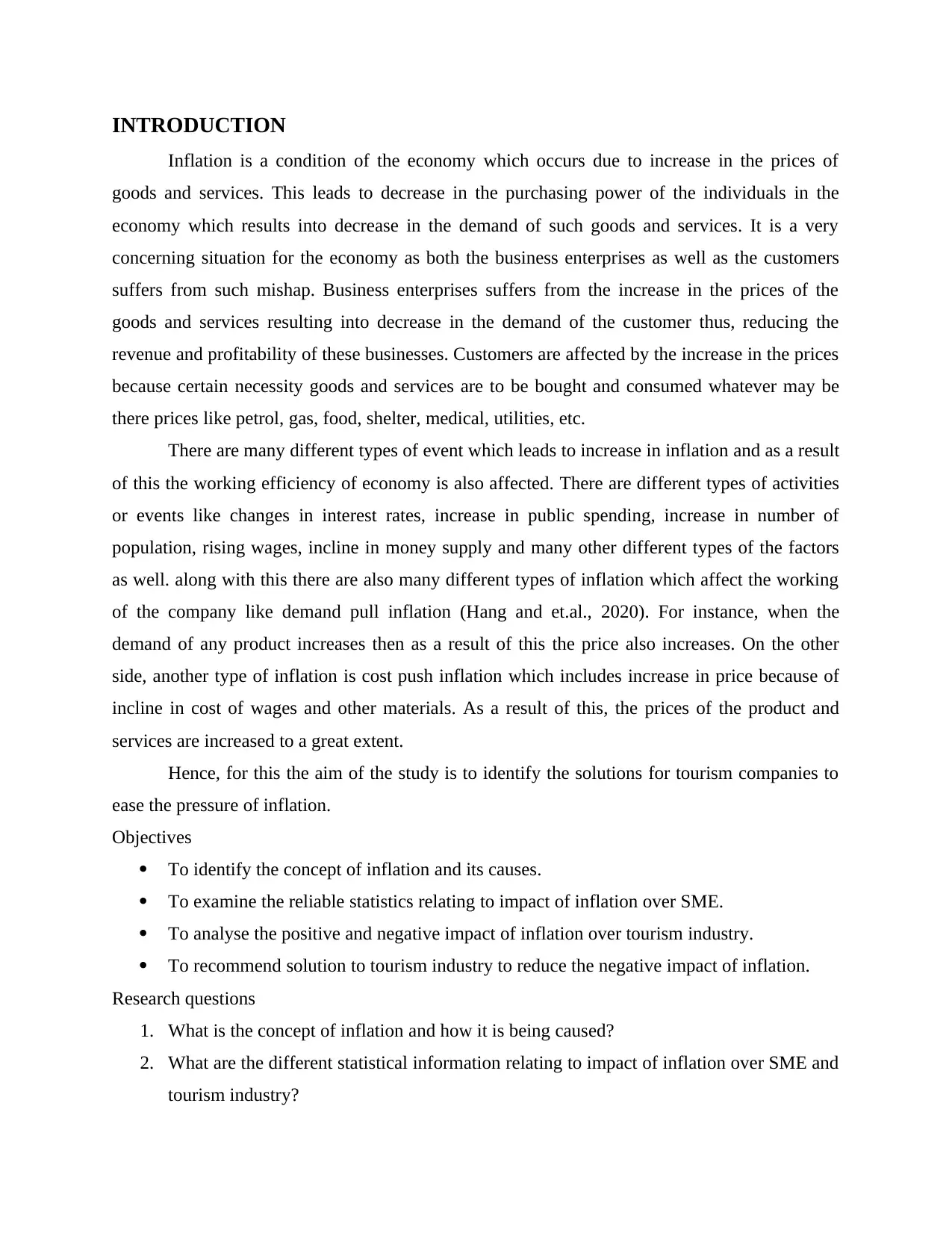
INTRODUCTION
Inflation is a condition of the economy which occurs due to increase in the prices of
goods and services. This leads to decrease in the purchasing power of the individuals in the
economy which results into decrease in the demand of such goods and services. It is a very
concerning situation for the economy as both the business enterprises as well as the customers
suffers from such mishap. Business enterprises suffers from the increase in the prices of the
goods and services resulting into decrease in the demand of the customer thus, reducing the
revenue and profitability of these businesses. Customers are affected by the increase in the prices
because certain necessity goods and services are to be bought and consumed whatever may be
there prices like petrol, gas, food, shelter, medical, utilities, etc.
There are many different types of event which leads to increase in inflation and as a result
of this the working efficiency of economy is also affected. There are different types of activities
or events like changes in interest rates, increase in public spending, increase in number of
population, rising wages, incline in money supply and many other different types of the factors
as well. along with this there are also many different types of inflation which affect the working
of the company like demand pull inflation (Hang and et.al., 2020). For instance, when the
demand of any product increases then as a result of this the price also increases. On the other
side, another type of inflation is cost push inflation which includes increase in price because of
incline in cost of wages and other materials. As a result of this, the prices of the product and
services are increased to a great extent.
Hence, for this the aim of the study is to identify the solutions for tourism companies to
ease the pressure of inflation.
Objectives
To identify the concept of inflation and its causes.
To examine the reliable statistics relating to impact of inflation over SME.
To analyse the positive and negative impact of inflation over tourism industry.
To recommend solution to tourism industry to reduce the negative impact of inflation.
Research questions
1. What is the concept of inflation and how it is being caused?
2. What are the different statistical information relating to impact of inflation over SME and
tourism industry?
Inflation is a condition of the economy which occurs due to increase in the prices of
goods and services. This leads to decrease in the purchasing power of the individuals in the
economy which results into decrease in the demand of such goods and services. It is a very
concerning situation for the economy as both the business enterprises as well as the customers
suffers from such mishap. Business enterprises suffers from the increase in the prices of the
goods and services resulting into decrease in the demand of the customer thus, reducing the
revenue and profitability of these businesses. Customers are affected by the increase in the prices
because certain necessity goods and services are to be bought and consumed whatever may be
there prices like petrol, gas, food, shelter, medical, utilities, etc.
There are many different types of event which leads to increase in inflation and as a result
of this the working efficiency of economy is also affected. There are different types of activities
or events like changes in interest rates, increase in public spending, increase in number of
population, rising wages, incline in money supply and many other different types of the factors
as well. along with this there are also many different types of inflation which affect the working
of the company like demand pull inflation (Hang and et.al., 2020). For instance, when the
demand of any product increases then as a result of this the price also increases. On the other
side, another type of inflation is cost push inflation which includes increase in price because of
incline in cost of wages and other materials. As a result of this, the prices of the product and
services are increased to a great extent.
Hence, for this the aim of the study is to identify the solutions for tourism companies to
ease the pressure of inflation.
Objectives
To identify the concept of inflation and its causes.
To examine the reliable statistics relating to impact of inflation over SME.
To analyse the positive and negative impact of inflation over tourism industry.
To recommend solution to tourism industry to reduce the negative impact of inflation.
Research questions
1. What is the concept of inflation and how it is being caused?
2. What are the different statistical information relating to impact of inflation over SME and
tourism industry?
⊘ This is a preview!⊘
Do you want full access?
Subscribe today to unlock all pages.

Trusted by 1+ million students worldwide
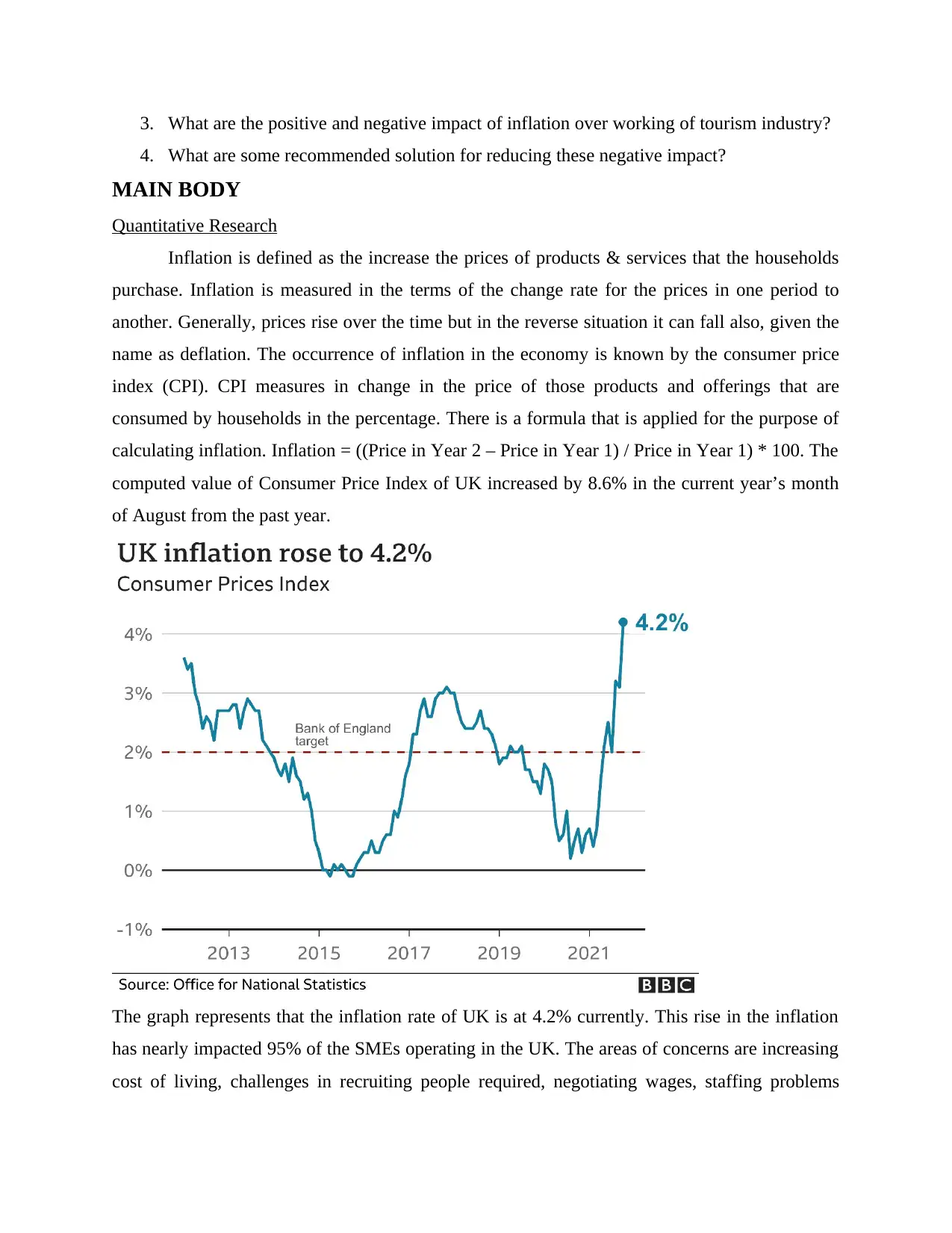
3. What are the positive and negative impact of inflation over working of tourism industry?
4. What are some recommended solution for reducing these negative impact?
MAIN BODY
Quantitative Research
Inflation is defined as the increase the prices of products & services that the households
purchase. Inflation is measured in the terms of the change rate for the prices in one period to
another. Generally, prices rise over the time but in the reverse situation it can fall also, given the
name as deflation. The occurrence of inflation in the economy is known by the consumer price
index (CPI). CPI measures in change in the price of those products and offerings that are
consumed by households in the percentage. There is a formula that is applied for the purpose of
calculating inflation. Inflation = ((Price in Year 2 – Price in Year 1) / Price in Year 1) * 100. The
computed value of Consumer Price Index of UK increased by 8.6% in the current year’s month
of August from the past year.
The graph represents that the inflation rate of UK is at 4.2% currently. This rise in the inflation
has nearly impacted 95% of the SMEs operating in the UK. The areas of concerns are increasing
cost of living, challenges in recruiting people required, negotiating wages, staffing problems
4. What are some recommended solution for reducing these negative impact?
MAIN BODY
Quantitative Research
Inflation is defined as the increase the prices of products & services that the households
purchase. Inflation is measured in the terms of the change rate for the prices in one period to
another. Generally, prices rise over the time but in the reverse situation it can fall also, given the
name as deflation. The occurrence of inflation in the economy is known by the consumer price
index (CPI). CPI measures in change in the price of those products and offerings that are
consumed by households in the percentage. There is a formula that is applied for the purpose of
calculating inflation. Inflation = ((Price in Year 2 – Price in Year 1) / Price in Year 1) * 100. The
computed value of Consumer Price Index of UK increased by 8.6% in the current year’s month
of August from the past year.
The graph represents that the inflation rate of UK is at 4.2% currently. This rise in the inflation
has nearly impacted 95% of the SMEs operating in the UK. The areas of concerns are increasing
cost of living, challenges in recruiting people required, negotiating wages, staffing problems
Paraphrase This Document
Need a fresh take? Get an instant paraphrase of this document with our AI Paraphraser
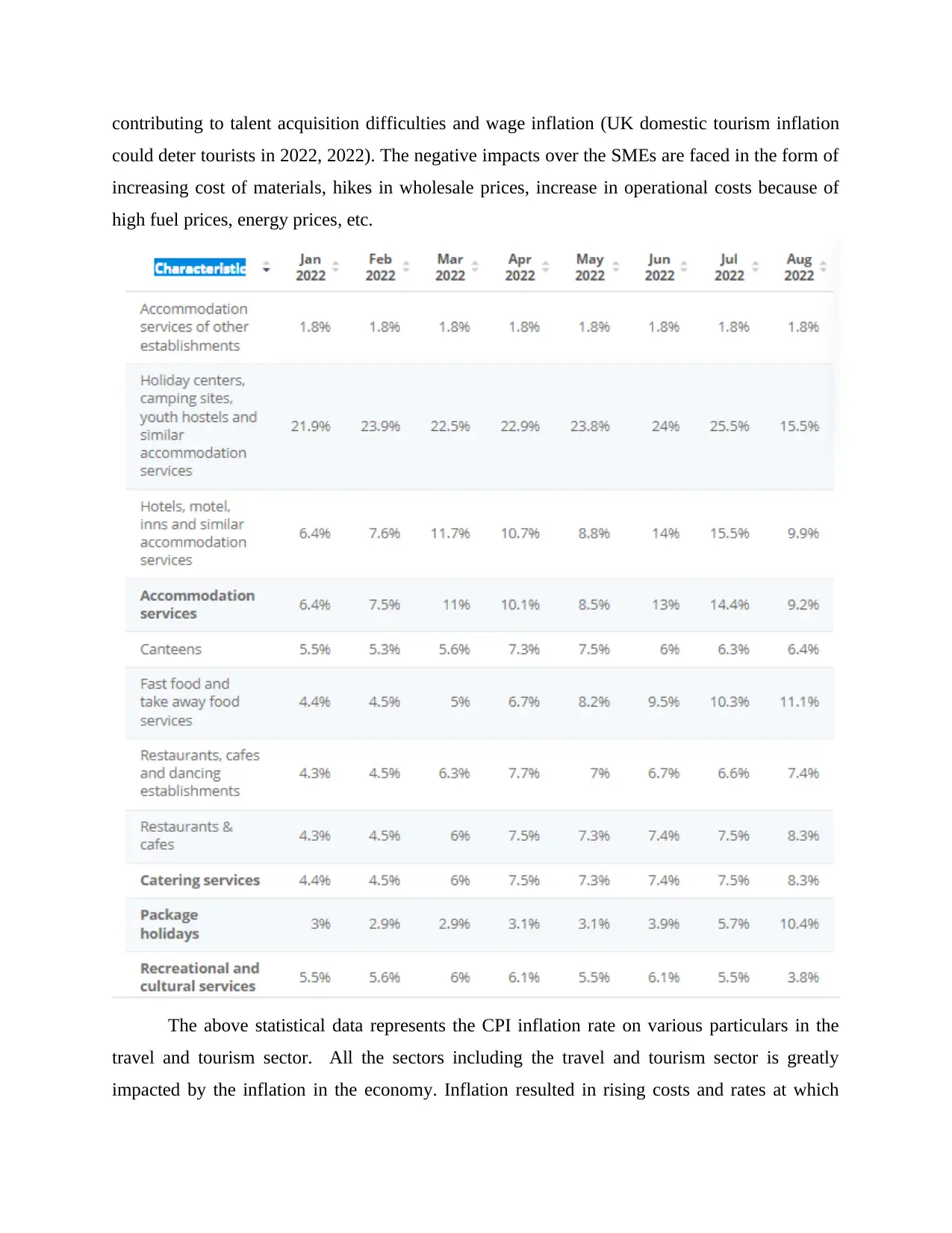
contributing to talent acquisition difficulties and wage inflation (UK domestic tourism inflation
could deter tourists in 2022, 2022). The negative impacts over the SMEs are faced in the form of
increasing cost of materials, hikes in wholesale prices, increase in operational costs because of
high fuel prices, energy prices, etc.
The above statistical data represents the CPI inflation rate on various particulars in the
travel and tourism sector. All the sectors including the travel and tourism sector is greatly
impacted by the inflation in the economy. Inflation resulted in rising costs and rates at which
could deter tourists in 2022, 2022). The negative impacts over the SMEs are faced in the form of
increasing cost of materials, hikes in wholesale prices, increase in operational costs because of
high fuel prices, energy prices, etc.
The above statistical data represents the CPI inflation rate on various particulars in the
travel and tourism sector. All the sectors including the travel and tourism sector is greatly
impacted by the inflation in the economy. Inflation resulted in rising costs and rates at which
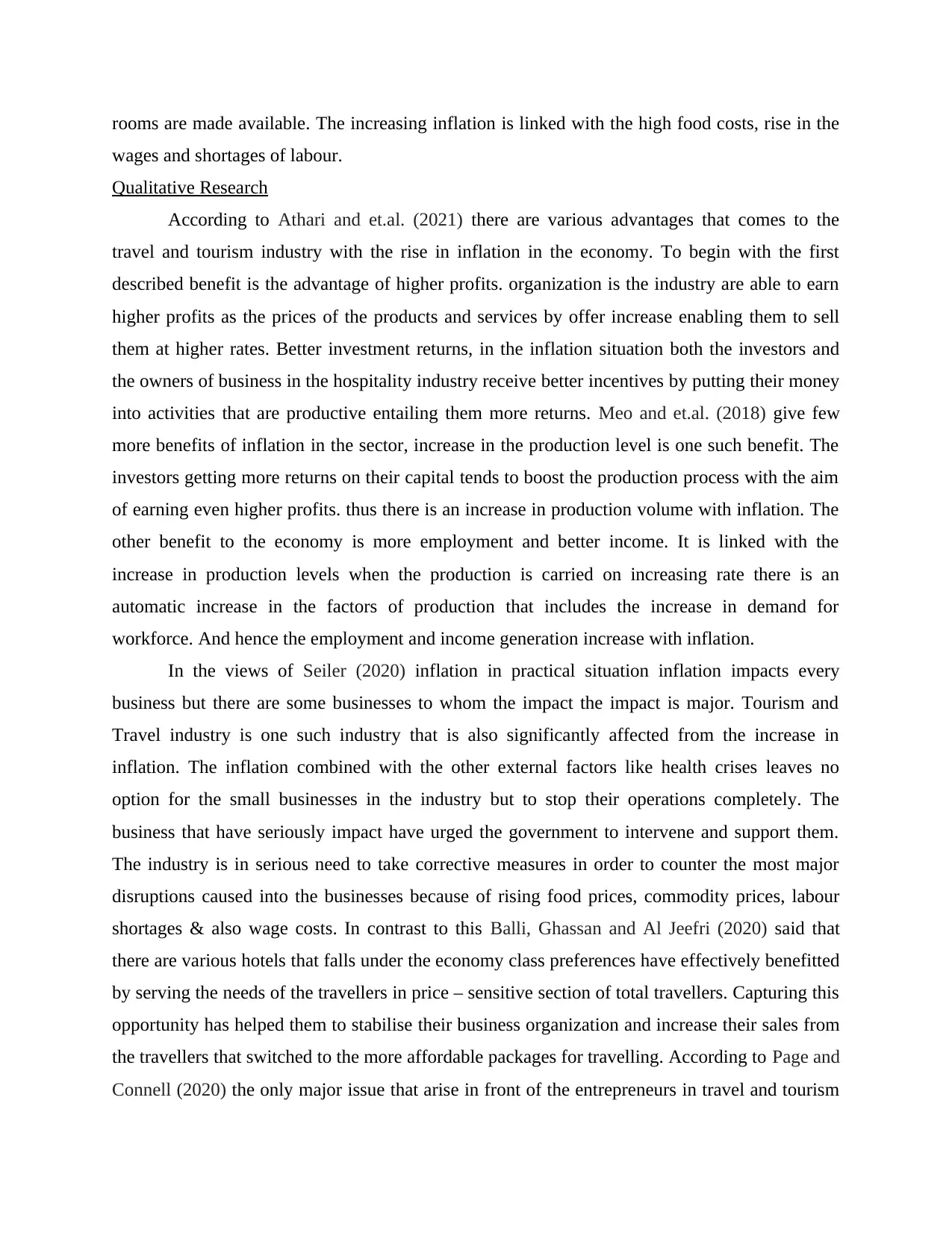
rooms are made available. The increasing inflation is linked with the high food costs, rise in the
wages and shortages of labour.
Qualitative Research
According to Athari and et.al. (2021) there are various advantages that comes to the
travel and tourism industry with the rise in inflation in the economy. To begin with the first
described benefit is the advantage of higher profits. organization is the industry are able to earn
higher profits as the prices of the products and services by offer increase enabling them to sell
them at higher rates. Better investment returns, in the inflation situation both the investors and
the owners of business in the hospitality industry receive better incentives by putting their money
into activities that are productive entailing them more returns. Meo and et.al. (2018) give few
more benefits of inflation in the sector, increase in the production level is one such benefit. The
investors getting more returns on their capital tends to boost the production process with the aim
of earning even higher profits. thus there is an increase in production volume with inflation. The
other benefit to the economy is more employment and better income. It is linked with the
increase in production levels when the production is carried on increasing rate there is an
automatic increase in the factors of production that includes the increase in demand for
workforce. And hence the employment and income generation increase with inflation.
In the views of Seiler (2020) inflation in practical situation inflation impacts every
business but there are some businesses to whom the impact the impact is major. Tourism and
Travel industry is one such industry that is also significantly affected from the increase in
inflation. The inflation combined with the other external factors like health crises leaves no
option for the small businesses in the industry but to stop their operations completely. The
business that have seriously impact have urged the government to intervene and support them.
The industry is in serious need to take corrective measures in order to counter the most major
disruptions caused into the businesses because of rising food prices, commodity prices, labour
shortages & also wage costs. In contrast to this Balli, Ghassan and Al Jeefri (2020) said that
there are various hotels that falls under the economy class preferences have effectively benefitted
by serving the needs of the travellers in price – sensitive section of total travellers. Capturing this
opportunity has helped them to stabilise their business organization and increase their sales from
the travellers that switched to the more affordable packages for travelling. According to Page and
Connell (2020) the only major issue that arise in front of the entrepreneurs in travel and tourism
wages and shortages of labour.
Qualitative Research
According to Athari and et.al. (2021) there are various advantages that comes to the
travel and tourism industry with the rise in inflation in the economy. To begin with the first
described benefit is the advantage of higher profits. organization is the industry are able to earn
higher profits as the prices of the products and services by offer increase enabling them to sell
them at higher rates. Better investment returns, in the inflation situation both the investors and
the owners of business in the hospitality industry receive better incentives by putting their money
into activities that are productive entailing them more returns. Meo and et.al. (2018) give few
more benefits of inflation in the sector, increase in the production level is one such benefit. The
investors getting more returns on their capital tends to boost the production process with the aim
of earning even higher profits. thus there is an increase in production volume with inflation. The
other benefit to the economy is more employment and better income. It is linked with the
increase in production levels when the production is carried on increasing rate there is an
automatic increase in the factors of production that includes the increase in demand for
workforce. And hence the employment and income generation increase with inflation.
In the views of Seiler (2020) inflation in practical situation inflation impacts every
business but there are some businesses to whom the impact the impact is major. Tourism and
Travel industry is one such industry that is also significantly affected from the increase in
inflation. The inflation combined with the other external factors like health crises leaves no
option for the small businesses in the industry but to stop their operations completely. The
business that have seriously impact have urged the government to intervene and support them.
The industry is in serious need to take corrective measures in order to counter the most major
disruptions caused into the businesses because of rising food prices, commodity prices, labour
shortages & also wage costs. In contrast to this Balli, Ghassan and Al Jeefri (2020) said that
there are various hotels that falls under the economy class preferences have effectively benefitted
by serving the needs of the travellers in price – sensitive section of total travellers. Capturing this
opportunity has helped them to stabilise their business organization and increase their sales from
the travellers that switched to the more affordable packages for travelling. According to Page and
Connell (2020) the only major issue that arise in front of the entrepreneurs in travel and tourism
⊘ This is a preview!⊘
Do you want full access?
Subscribe today to unlock all pages.

Trusted by 1+ million students worldwide

industry in rising levels of inflation is the unemployment. This challenge is further linked with
the more contribution to the rise in prices.
CONCLUSION
With the above analysis it is concluded inflation is an economic aspect which affects the
business and the working of the different industries. Thus, for the effective working of various
industries it is very necessary that the effective strategies for better working are being used and
complied. Some of the suggestion which need to be followed by tourism industry to reduce the
negative impact of inflation over its working are as follows-
The first and foremost recommended solution for tourism industry to mitigate inflation is
that they must try to control the money supply. The reason underlying this fact is that there is a
close link between the inflation and money supply. Hence, when the money supply will be more
then prices will be high and for managing this, tourism sector need to control the supply of
money within the economy (7 ways to beat travel inflation, 2022). When people will not be
having much money then they will not be demand the different product and as a result of this
demand will contract resulting in decline in prices that in inflation.
Along with this another strategy which can be implemented by tourism sector for
managing inflation is to control the prices and wages. The controlling of wages and prices will
definitely help the companies in tourism sector to make reduction in inflationary pressure.
In addition to this, the use of exchange rate pegging is also another good strategy which
tourism industry can use in order to reduce inflation. Under this strategy, the country tries to
keep its currency value low as compared to the other large, low inflation country. This is done in
order to attract that tourists from other countries and as a result of this the inflation might reduce.
The major benefit of using this type of strategy for tourism industry is that it provides for a
nominal anchor which prevents the issue of time inconsistency.
Hence, by using these different types of the strategies different companies and industry
can try to reduce the effects of inflation over the economy (Athari and et.al., 2021). Hence, as a
result of this the working capability of country increases and improves the working efficiency to
a great extent.
the more contribution to the rise in prices.
CONCLUSION
With the above analysis it is concluded inflation is an economic aspect which affects the
business and the working of the different industries. Thus, for the effective working of various
industries it is very necessary that the effective strategies for better working are being used and
complied. Some of the suggestion which need to be followed by tourism industry to reduce the
negative impact of inflation over its working are as follows-
The first and foremost recommended solution for tourism industry to mitigate inflation is
that they must try to control the money supply. The reason underlying this fact is that there is a
close link between the inflation and money supply. Hence, when the money supply will be more
then prices will be high and for managing this, tourism sector need to control the supply of
money within the economy (7 ways to beat travel inflation, 2022). When people will not be
having much money then they will not be demand the different product and as a result of this
demand will contract resulting in decline in prices that in inflation.
Along with this another strategy which can be implemented by tourism sector for
managing inflation is to control the prices and wages. The controlling of wages and prices will
definitely help the companies in tourism sector to make reduction in inflationary pressure.
In addition to this, the use of exchange rate pegging is also another good strategy which
tourism industry can use in order to reduce inflation. Under this strategy, the country tries to
keep its currency value low as compared to the other large, low inflation country. This is done in
order to attract that tourists from other countries and as a result of this the inflation might reduce.
The major benefit of using this type of strategy for tourism industry is that it provides for a
nominal anchor which prevents the issue of time inconsistency.
Hence, by using these different types of the strategies different companies and industry
can try to reduce the effects of inflation over the economy (Athari and et.al., 2021). Hence, as a
result of this the working capability of country increases and improves the working efficiency to
a great extent.
Paraphrase This Document
Need a fresh take? Get an instant paraphrase of this document with our AI Paraphraser

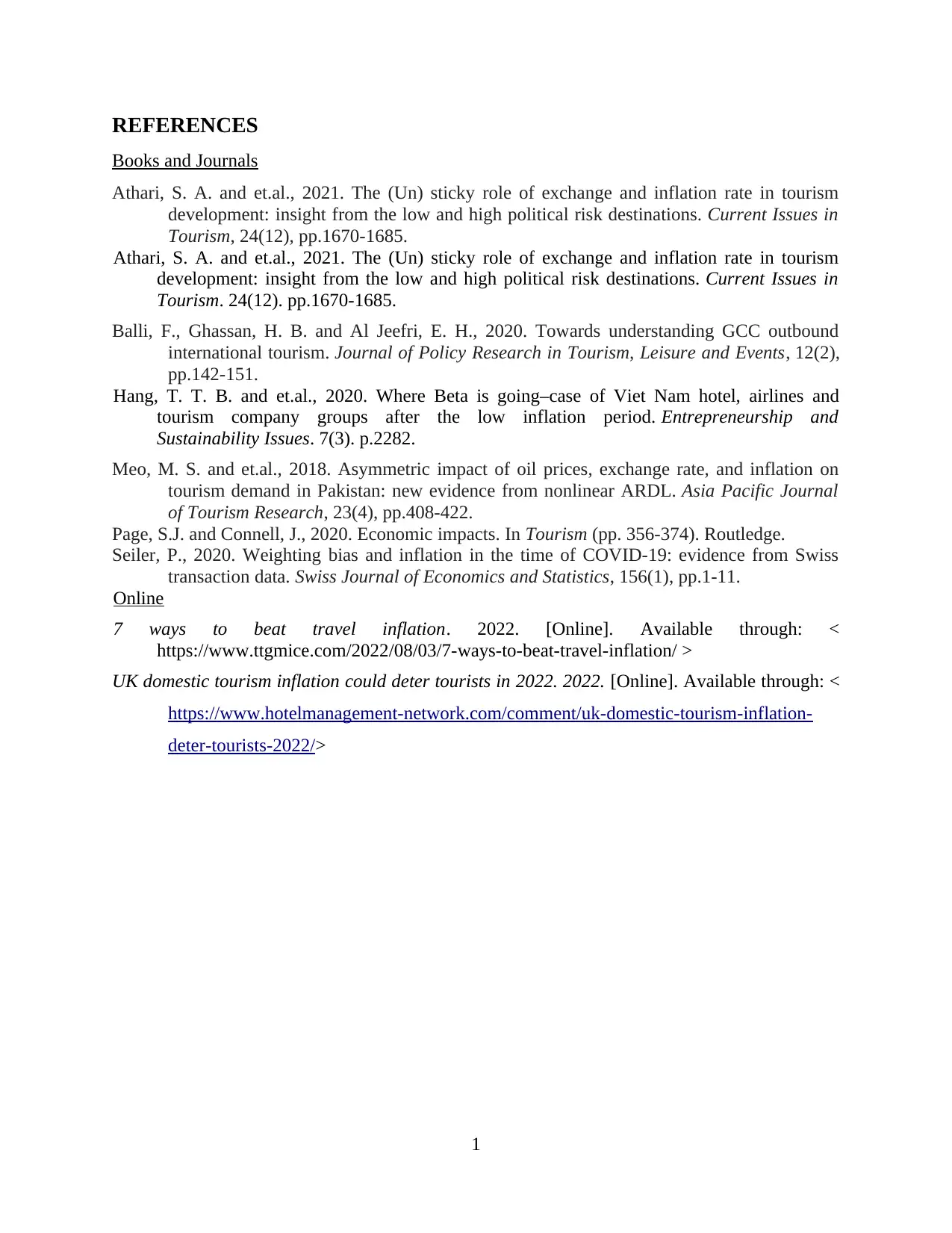
REFERENCES
Books and Journals
Athari, S. A. and et.al., 2021. The (Un) sticky role of exchange and inflation rate in tourism
development: insight from the low and high political risk destinations. Current Issues in
Tourism, 24(12), pp.1670-1685.
Athari, S. A. and et.al., 2021. The (Un) sticky role of exchange and inflation rate in tourism
development: insight from the low and high political risk destinations. Current Issues in
Tourism. 24(12). pp.1670-1685.
Balli, F., Ghassan, H. B. and Al Jeefri, E. H., 2020. Towards understanding GCC outbound
international tourism. Journal of Policy Research in Tourism, Leisure and Events, 12(2),
pp.142-151.
Hang, T. T. B. and et.al., 2020. Where Beta is going–case of Viet Nam hotel, airlines and
tourism company groups after the low inflation period. Entrepreneurship and
Sustainability Issues. 7(3). p.2282.
Meo, M. S. and et.al., 2018. Asymmetric impact of oil prices, exchange rate, and inflation on
tourism demand in Pakistan: new evidence from nonlinear ARDL. Asia Pacific Journal
of Tourism Research, 23(4), pp.408-422.
Page, S.J. and Connell, J., 2020. Economic impacts. In Tourism (pp. 356-374). Routledge.
Seiler, P., 2020. Weighting bias and inflation in the time of COVID-19: evidence from Swiss
transaction data. Swiss Journal of Economics and Statistics, 156(1), pp.1-11.
Online
7 ways to beat travel inflation. 2022. [Online]. Available through: <
https://www.ttgmice.com/2022/08/03/7-ways-to-beat-travel-inflation/ >
UK domestic tourism inflation could deter tourists in 2022. 2022. [Online]. Available through: <
https://www.hotelmanagement-network.com/comment/uk-domestic-tourism-inflation-
deter-tourists-2022/>
1
Books and Journals
Athari, S. A. and et.al., 2021. The (Un) sticky role of exchange and inflation rate in tourism
development: insight from the low and high political risk destinations. Current Issues in
Tourism, 24(12), pp.1670-1685.
Athari, S. A. and et.al., 2021. The (Un) sticky role of exchange and inflation rate in tourism
development: insight from the low and high political risk destinations. Current Issues in
Tourism. 24(12). pp.1670-1685.
Balli, F., Ghassan, H. B. and Al Jeefri, E. H., 2020. Towards understanding GCC outbound
international tourism. Journal of Policy Research in Tourism, Leisure and Events, 12(2),
pp.142-151.
Hang, T. T. B. and et.al., 2020. Where Beta is going–case of Viet Nam hotel, airlines and
tourism company groups after the low inflation period. Entrepreneurship and
Sustainability Issues. 7(3). p.2282.
Meo, M. S. and et.al., 2018. Asymmetric impact of oil prices, exchange rate, and inflation on
tourism demand in Pakistan: new evidence from nonlinear ARDL. Asia Pacific Journal
of Tourism Research, 23(4), pp.408-422.
Page, S.J. and Connell, J., 2020. Economic impacts. In Tourism (pp. 356-374). Routledge.
Seiler, P., 2020. Weighting bias and inflation in the time of COVID-19: evidence from Swiss
transaction data. Swiss Journal of Economics and Statistics, 156(1), pp.1-11.
Online
7 ways to beat travel inflation. 2022. [Online]. Available through: <
https://www.ttgmice.com/2022/08/03/7-ways-to-beat-travel-inflation/ >
UK domestic tourism inflation could deter tourists in 2022. 2022. [Online]. Available through: <
https://www.hotelmanagement-network.com/comment/uk-domestic-tourism-inflation-
deter-tourists-2022/>
1
⊘ This is a preview!⊘
Do you want full access?
Subscribe today to unlock all pages.

Trusted by 1+ million students worldwide
1 out of 9
Related Documents
Your All-in-One AI-Powered Toolkit for Academic Success.
+13062052269
info@desklib.com
Available 24*7 on WhatsApp / Email
![[object Object]](/_next/static/media/star-bottom.7253800d.svg)
Unlock your academic potential
Copyright © 2020–2025 A2Z Services. All Rights Reserved. Developed and managed by ZUCOL.

